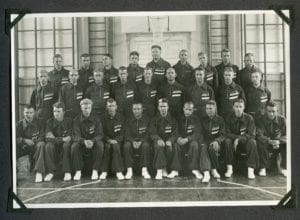When I visit the USA, I adopt the mindset of “the foreign correspondent”
Update
As noted in a comment at the end of this post, the flippant tone of my review of the Chicago Tribune “gentrification” article is perhaps not warranted.
Accordingly, a tentative bottom line that occurs to me, influenced by the preface by Richard J. Evans in the first of his three books – his trilogy – about Nazi Germany, is that a writer is best to keep to a minimum the moral and ethical “baggage” that can be brought to a writing task, in that way leaving it up to the reader to decide, in whichever way occurs to the reader, what the most appropriate way will be, for the reader to judge – in the context of morality, ethics, and the like – the information and details that a writer has shared.
[End]
Many people that I know in Toronto like to visit Buffalo.
I’ve been there a few times.
In previous years I wasn’t much interested in travelling to Buffalo but now I’m starting to see it can be a lot of fun – a visit to a foreign country.
On Sunday, Nov. 19, 2017 on my most recent visit, I enjoyed a stop at Wegmans at 651 Dick Road in Depew, NY.
Wegmans is a great place to do some shopping; the setting is cheerful and the food (assuming you choose wisely, of course) is good, and healthy. You can stop for a snack right in the store, paying for it at a cashier, leaving your cart full of groceries nearby while you eat, and before you proceed to a checkout.
I noted that the warning-signage at the Wegmans parking lot and elsewhere is written in clearly worded declarative sentences often backed up by implicit or explicit references to the rule of law.
On a Sunday, the travel through customs went quickly, wherever it was that we crossed. (I wasn’t driving, so I didn’t pay attention.)
I would describe it as a cross-cultural experience. I like to approach a visit to the USA through “the eyes of a foreign correspondent.”
In fact, I like to approach events and happenings in Long Branch in Toronto, where I live, on the same terms.
I was especially interested in the magazine racks at Wegmans and bought two magazines – the November / December 2017 issue of Dwell: At Home in the Modern World; and the October 2017 issue of New York Spaces: The Home Design Magazine of Metropolitan New York. There’s a particular design project that I’m interested in and the magazines were helpful in getting me oriented with regard to it.
There’s a standard visual trope or meme that recurs in such magazines. The meme features an appealing view of untrammelled nature, as seen through a picture window of an artfully designed interior. I am reminded of the machine in the garden trope of postwar industrial land-use design.
Plus, I like to see print magazines that have a good business model, that enable them to survive, and reach a paying audience.
A cross-cultural experience
I also came across a copy of the Sunday (Nov. 19, 2017) edition of The Buffalo News. The front page of the Business Section of the latter paper gave readers notice that an article on Page G7 addressed a most intriguing topic, that is to say: “Exploding common myths about housing: Statistics uncover reality of gentrification, poverty and property values.”

On Nov. 19, 2017 we drove from Toronto to visit Wegmans on Dick Road in Depew, NY and to visit Williamsville, NY where a fabled Talbots outlet is located. Jaan Pill photo
The article, from the Oct. 18, 2017 Chicago Tribune, is entitled: “3 housing myths, debunked: Poverty, property values, and gentrification.”
The opening paragraph notes that “as one grows more attached to a residence over the years, feelings often deepen as house becomes home and memories start to accumulate.”
Well, I would say that sometimes as the years pass, a person becomes less attached. It depends on the person, and the family.
The article notes, anyway, that “According to experts,” “myths abound” regarding “gentrification, poverty and low-income housing.”
First myth of gentrification, according to Oct. 18, 2017 Chicago Tribune article
“Myth 1: Gentrification has as much to do with morals as with economics,” the article notes, and adds that varied definitions exist regarding gentrification. An expert is quoted who asserts that gentrification “becomes sticky only when we assign moral weight to the term.”
Good to know.
The expert is quoted as attending to the relevance of the terms:
- demarcation
- devaluation
- deterioration
- demolition, and
- defunding
The bottom line, if you follow the narration to its logical conclusion, is that gentrification carries no moral weight at all.
Having made quick work of the first myth, the text turns to the second on the list.
Second myth
“Myth 2: There is more poverty in cities than in suburbs.”
Statistics are referenced indicating the poverty has reared its head in the suburbs as well.

The house on the left in Williamsville, NY caught my eye. A resident that I spoke with said the house appears to be slated for demolition at some point down the road. Jaan Pill photo
An expert is quoted as observing: “I think we’re not aware of these trends in part because suburbs were created to be exclusive places … and therefore no suburb really wants to think they have a poverty problem, partly because it may require them to do something about it — but it also may affect their ability to maintain property values or to attract new homeowners.”
What’s interesting, the article adds, is that “poverty is as segregated in suburbs as it is in cities.”

As I understand from speaking with a local resident, this house dates from the early 1800s and belongs to a judge, who has made sure the interior is in great shape. Jaan Pill photo
How can poverty become a thing of the past both in cities and suburbs? Strengthen safety nets, the article says. That will solve the problem.
And we proceed to the third myth.
Third myth
“Myth 3: Having low-income housing in your community reduces property values.”
The topic is covered in a manner that is of interest. If you have an interest in learning about this myth, please refer to the Chicago Tribune article, at the conclusion of which you will be de-mystified.

This house caught my eye because it has an expressive quality to it. I like to think it was designed a long time ago, by an architect sitting at an old-time, analog drafting table. Jaan Pill photo
It’s an enjoyable article. I also bought a print edition of the Sunday New York Times. It’s a fun read but I do keep in mind that the paper acted as a “stenographer to power” during the run-up to the American invasion of Iraq. It’s one of those little things that I keep in mind, as I read the New York Times.
I like the way the stories are structured. They have a start, middle, and end and things do appear to fit into place well, my recollections about Iraq notwithstanding.
Sometimes, a copy of the Sunday edition is enough to keep me reading for several months. I like to make a close study of articles that I read, when I can. That takes time, and some concentration of attention. I like especially to consider how the stories are constructed, and how language is used to advance particular arguments or themes. The New York Times is a fun paper. There is much of value in the contents from what I can see.
Williamsville, NY
From Wegmans on Dick Road in Depew, NY, we next travelled to a fabled Talbot’s outlet in Williamsville, NY. You can save a lot of money by buying things online in Canada, and then going to the Talbots outlet to pick them up. If they don’d fit, you get a refund there and then, as I understand. (I don’t follow all the details.)
I had close to an hour to spare, as I was not involved with the in-store Talbot’s visit. This was my second visit to Williamsville. On this occasion, I walked along Main Street for some distance, stopping at some historic houses that caught my eye.

Group portrait of athletes, from the University of Tartu in Estonia, who attended the 1936 Berlin Olympics as student observers. The photo was taken, I believe, in 1936 or earlier. Source: Kaljo Pill
I noted that many historic buildings in Williamsville have been repurposed for contemporary uses. I also learned that one old building, which in particular caught my eye, may be headed toward a tear-down as part of a new development.
I also learned, through a conversation with a local resident (who as often occurs, asked what I was doing with my camera) that another historic house, dating from the early 1800s, is fortunately not under threat, as a local judge has purchased it and is taking great care to fix up the interior.
What was I doing with my camera? I was a visitor from Toronto (you can tell by my accent) and I enjoy taking pictures of historic houses, wherever it is that I am travelling.
I do not know what kind of heritage preservation regime is in place in Williamsville, or elsewhere in New York state, but am keen to learn more.

Kaljo Pill, age about 21. Detail from 1936 group photo of young athletes from Estonia, who attended the 1936 Berlin Olympics as student observers. Source: Kaljo Pill
I also walked along a residential area where one house in particular caught me eye, as it had an expressiveness about it – as if it had jumped off of an architect’s old-time drafting table to appear fully fleshed out, in its good-natured expressiveness, as a reality on the ground.
That house was designed using analog methods – as in drawings on a drafting table; I am relatively certain of that. It does not look like a house that an architectural technician (who is not an architect) would design using a software program, as perhaps has become standard practice in many places in the world today. (Some of those places include Long Branch, where I live now.)
Richard J. Evans
On the way to Buffalo and on my way back, I read three passages from three books, namely:
The Third Reich at War (2008) by Richard J. Evans, and two books on strength training,
Bigger, Faster, Stronger: The Proven System for Developing Athletes (2017) by Ken Shepard and Kim Gross; and
Eat. Lift. Thrive (2017) by Sohee Lee
I’ve been reading all three of Richard J. Evans’ trilogy of books about Nazi Germany – focusing upon the coming to power of the regime; the years it was in power up to 1939; and its conduct in wartime – as well as several other books addressing several related themes. I began an intensive process of focused reading of recent studies in this area, after a close study of my father’s photo album from the 1936 Berlin Summer Olympics.




Among the books referenced in the above-noted Chicago Tribune article is Gentrifier (2017). A Toronto Public Library blurb for the books reads:
Summary/Review: “As urban job prospects change to reflect a more ‘creative’ economy and the desire for a particular form of ‘urban living’ continues to grow, so too does the migration of young people to cities. Gentrification and gentrifiers are often understood as ‘dirty’ words, ideas discussed at a veiled distance. Gentrifiers, in particular, are usually a ‘they.’ Gentrifier demystifies the idea of gentrification by opening a conversation that links the theoretical and the grassroots, spanning the literature of urban sociology, geography, planning, policy, and more. Along with established research, new analytical tools, and contemporary anecdotes, John Joe Schlichtman, Jason Patch, and Marc Lamont Hill place their personal experiences as urbanists, academics, parents, and spouses at the centre of analysis. They expose raw conversations usually reserved for the privacy of people’s intimate social networks in order to complicate our understanding of the individual decisions behind urban living and the displacement of low-income residents. The authors’ accounts of living in New York City, San Diego, Chicago, Philadelphia, and Providence link economic, political, and sociocultural factors to challenge the readers’ current understanding of gentrification and their own roles within their neighbourhoods.”
The above-noted Chicago Tribune article also refers to the work of Scott Allard, whose most recent book, “Places in Need: The Changing Geography of Poverty,” is not available at the Toronto Public Library.
An earlier book by him, Out of Reach: Place, Poverty, and the New American Welfare State (2009) is available; the blurb for it reads:
Sweeping changes in welfare programs since 1996 have transformed the way America cares for its poor. Today, for every dollar spent on cash welfare payments, some twenty dollars are spent on service programs targeted at the working poor–job training, adult education, child care, emergency assistance, mental health care, and other social services. This important book examines our current system and the crucial role that geography plays in the system’s ability to offer help.
Drawing on unique survey data from almost 1,500 faith-based and secular service organizations in three cities, Scott W. Allard examines which agencies are most accessible to poor populations and looks at the profound impact of unstable funding on assistance programs. Allard argues that the new system has become less equitable and reliable, and he concludes with practical policy recommendations that address some of the more pressing issues in improving the safety net.
Scott Allard is also an editor of Reconsidering the Urban Disadvantaged: The Role of Systems, Institutions, and Organizations, published by The Annals of the American Academy of Political and Social Science; May 2013, Volume 647; a blurb reads:
The recent economic recession and a sluggish recovery have made conditions especially precarious for the most disadvantaged members of the urban poor population–those with criminal records, health conditions, undocumented status, or unstable housing. The authors in this volume of The ANNALS argue that the fewer the resources to which people have access, the more their circumstances will depend on the organizations in which they participate, the systems in which these organizations operate, and the institutions governing the behavior of both.
Over the last 25 years, social science on urban poverty has grappled primarily with evidence of deindustrialization and the loss of low-skilled manufacturing jobs. In turn, structural economic change has transformed family structure, educational attainment, crime, and geographic concentration of the poor. Researchers have approached these issues from a limited set of theoretical perspectives, perspectives wherein the core units of analysis, aside from the market, have been the individual and the neighborhood. The editors of this volume argue that, today, understanding the conditions of these highly disadvantaged populations requires a focus on not only individuals and their neighborhoods but also, and perhaps more importantly, on the organizations that structure their lives, the systems in which those organizations are embedded, and the institutions that regulate both.
COMMENT: I note that the tone of my review of the above-noted Chicago Tribune article is somewhat flippant. When I had a closer look at the references, included in the article, I’ve concluded that my initial flippancy may not be as warranted as I had thought, when I first encountered the article.
With regard to tropes and memes related to our view of nature, alluded to in the blog post you are now reading, of interest is a book by Christopher Schaberg entitled: Airportness: The Nature of Flight (2017) for which a blurb reads: “Explores the surprising connections between the common experience of air travel and how we think about nature”.
A related book by Christopher Schaberg is entitled: The Textual Life of Airports: Reading the Culture of Flight (2013); a blurb reads:
This is a book about airport stories. It is about common narratives of airports that circulate in everyday life, and about the secret stories of airports – the strange or hidden narratives that do not always fit into standard ideas of these in-between places. Tales of near disaster, endless delays, dramatic weather shifts, a lost bag that suddenly appears – such stories are familiar accounts of a place that seems to thrive on and recycle its own mythologies.
The Textual Life of Airports shows how airports demand to be read. Working at the intersection of literary studies and cultural theory, Schaberg tracks airport stories in American literature, as well as in a range of visual texts (film, airport art, magazine illustrations). It accounts for how airports appear in literature throughout the twentieth-century, while also examining the influx of airport figures in markedly post-9/11 literature and culture. These literary and cultural representations work together to form the textual life of airports.